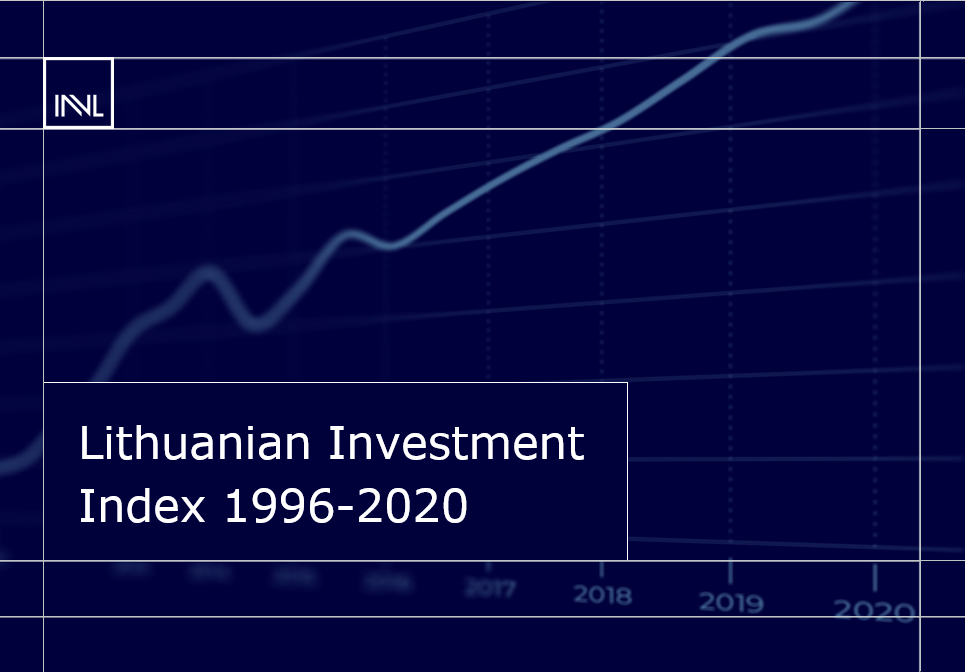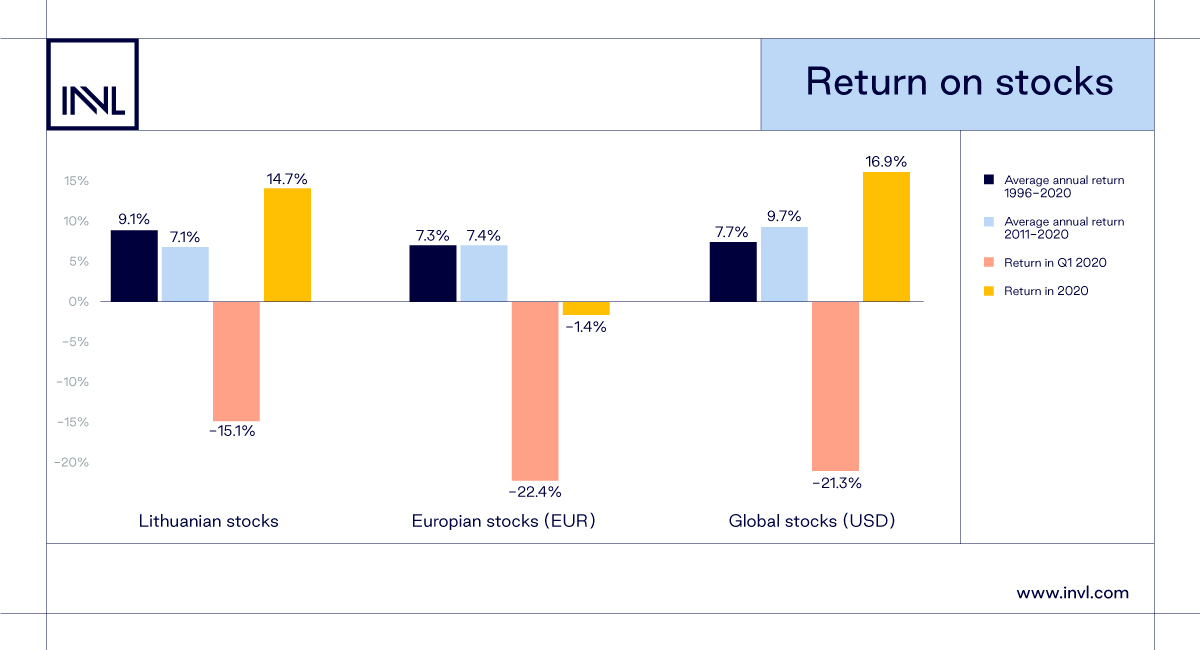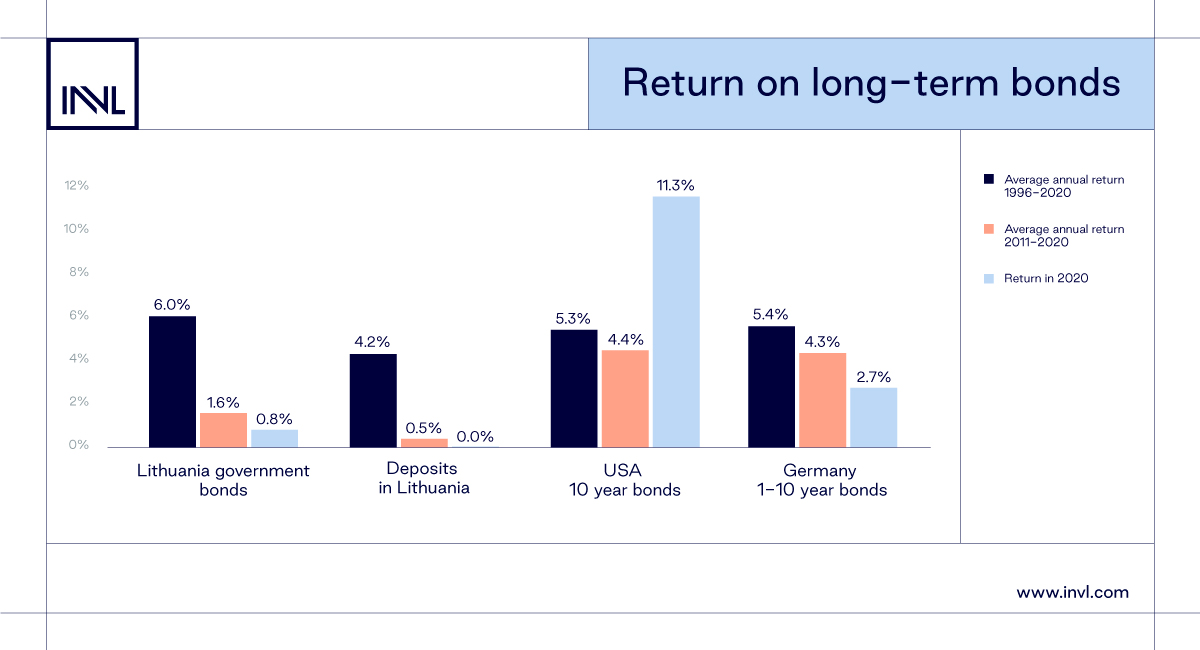


While the coronavirus pandemic caused turmoil in financial markets at the start of last year, in the end the Lithuanian Investment Index had a positive result once again. According to INVL Asset Management, which has compiled the investment index for 25 years now, last year the index increased for a ninth consecutive year and was up 6%, while its average annual gain in 1996-2020 was 9.6%. The investment index consists of the country’s main asset classes weighted equally and assessed annually: stocks, bonds, rental housing, and deposit rates.
“Last year again showed that the inevitable downturns should be viewed in the long-term perspective. The index’s rise in 2020 was due to strong recovery of the country’s stock market as well as housing that generated rental income. The Lithuanian Investment Index only fell by 3.2% in the first quarter of 2020 and has not decreased in any year since 2011 – that demonstrates once more that diversification of investments provides stability in times of change,” said Vaidotas Rūkas, the Chief Investment Officer at INVL Asset Management.
Stocks brought the biggest return in 2020
As shown by analysis of investments through the end of 2020, stocks earned the biggest investment return in Lithuania. Lithuania’s stock market grew an impressive 14.7% last year. Despite fluctuations, over a 5-year period the country’s stocks had the biggest annual return, at 10.9%, while over a 10-year period their return was 7.1% and over the last 20 years it was 11.5%.
According to Vaidotas Rūkas, the return on stocks was negative in the first quarter of 2020, but strong market recovery led to a significantly bigger-than-average annual return in Lithuania and worldwide. Unlike in Western Europe, the return on Lithuanian stocks did not trail the U.S. For both the last decade and the last 25 years, the average annual return on European, global and Lithuanian stocks is solid and notably higher than inflation.

Placing second last year for return on investment was investments in housing, the value of which rose 4.1%, or 8.4% if rental income is included. Considering the last 10 years, the average annual growth in the value of Lithuanian rental housing was 7.5%, while over the past 20 years of the index’s compilation the average annual return on rental housing was 12.3%, making it the country’s most profitable asset class.
In 2020, Eurozone and U.S. government bonds had different starting points. Even though the Federal Reserve has been gradually reducing interest rates since 2018, it met the pandemic of 2020 with the ability to cut rates by a full 1.5% to 0%. The European Central Bank (ECB), however, had already set an interest rate of -0.5%. And that divergence of base interest rates led to double-digit growth in the price of U.S. government bonds.
Looking at a longer, 25-year period, Lithuanian government bonds generated a 6% annual return, despite a merely symbolic gain last year. If two decades ago Lithuania was deemed a risky sovereign, today it is rated among the safer countries and even last year, when the pandemic broke out, investors did not massively sell its bonds like they did during the crisis of 2008-2009.

The return on Lithuanian deposits remained at zero in 2020 for a sixth year in a row, thus the long-term average return on this asset class since 1996 shrank to 4.2%.
Pension funds’ advantage is age-based risk reduction
Although last year was full of surprises, the assets of Lithuanian residents held in 2nd pillar pension funds grew 15.7%. The annual return on those assets, meanwhile, was 5.2% and was equal to the long-term average return of 5.2% since the funds began operating in 2004.
“Since 2019, Lithuania’s 2nd pillar funds have been managed on a lifecycle basis and provide the opportunity to maximally diversify investments based on age-based appetite for risk. The Lithuanian Investment Index confirms the benefits of such diversification – while certain of its asset classes grew more than the overall portfolio, diversifying investments like that makes it possible to balance their riskiness and earn adequate average return over the long term,” Vaidotas Rūkas said.
It is important to recall, the investment expert noted, that saving in pension funds is a long-term process, one that takes several decades, during which there will certainly be some fluctuations. What is more, a market downturn offers the opportunity, when investing periodically, to acquire more units of a pension fund for the same price. One more important advantage of pension funds is that the funds diversify investments and take thousands of varied positions, thereby reducing the risk of one or another losing value.
Stocks have the most favourable outlook
Looking at further prospects in the country, stocks continue to remain an excellent investment instrument to pursue an above-average return. While in the short term they show volatility, in a long-term sense they have a positive outlook due to the sustainable growth of the economy.
“Retail investors are seen to be increasingly active on the Baltic markets. In 2020, roughly two of every three investors were retail investors, and they generated more than half of all Baltic stock turnover. That trend may be influenced by the opportunity that has arisen in Lithuania to invest without commission fees, which will only further boost retail investors’ level of activity,” the investor said.
Looking at investment in housing, price growth may be near the level of inflation and rental yields are likely to be a bigger factor in determining returns. Significant divergence is possible among different housing segments, which will be influenced by people’s evolving or increasing priorities after the pandemic.
No changes are seen for holding money in deposits, with the investment return set to remain at nil. As for bonds, returns such as those seen historically cannot be forecast for the short and medium terms, as bond yields currently are at record lows.
Returns for Lithuanian asset classes
| Asset class* | 1996-2020 average annual return, % | 2011-2020 average annual return, % | 2020 return, % |
| Rental housing (net of expenses starting in 2016) | 7.3 | 4.7 | 4.3 |
| Housing prices in Lithuania | 6.3 | 2.8 | 4.1 |
| Lithuanian stocks | 9.1 | 7.1 | 14.7 |
| Short-term Lithuanian debt securities and money market instruments (deposits) | 4.2 | 0.5 | 0.0 |
| Lithuanian long-term bonds | 6.0 | 1.6 | 0.8 |
| Lithuanian 2nd pillar pension funds | 5.2** | 5.2 | 5.2 |
| Inflation | 3.1 | 1.8 | 1.1 |
| Lithuanian Investment Index | 9.6 | 4.6 | 6.0 |
* Housing acquisition and rental returns calculated on the basis of Ober-Haus data.
** Since their creation in 2004.
The information which is provided for information purposes cannot be construed as a recommendation, offer or invitation to invest in funds or other financial instruments managed by INVL Asset Management. When investing, you assume the investment risk. Investments can be both profitable and loss-making, you may not obtain financial benefits, and you may lose some or even all of the invested amount. Past results of investments do not guarantee future results. When making a decision to invest, you should assess all the risks associated with investing and the key investor information documents. INVL Asset Management is not responsible for any inaccuracies or changes in this information or for losses that may arise when investments are based on this information.
![]()
INVL and Šiaulių bankas merged their retail services as of 1 December 2023.
Please select Your topic on SB.lt webpage.
![]()
INVL and Šiaulių bankas merged their retail services as of 1 December 2023.